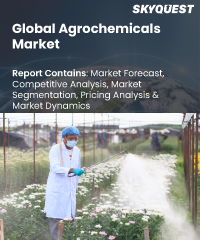
Report ID: SQMIG15C2066
Skyquest Technology's expert advisors have carried out comprehensive research on the agrochemicals market to identify the major global and regional market trends and growth opportunities for leading players and new entrants in this market. The analysis is based on in-depth primary and secondary research to understand the major market drivers and restraints shaping the future development and growth of the industry.
REQUEST FOR SAMPLE
In 2024, the agrochemicals industry was valued at USD 261.38 billion globally. In 2032, it is projected to be worth USD 346.86 billion, growing steadily at a CAGR of 3.6% throughout the forecast period of 2025–2032.
Clariant AG (Switzerland), BASF SE (Germany), Huntsman International LLC (US), Bayer AG (Germany), The DOW Chemical Company (US), Nufarm (Australia), Evonik Industries AG (Germany), Croda International Plc (UK), Helena Agri-Enterprises, LLC (US), Land O Lakes, Inc. (US), FMC Corp. (US), Stepan Company (US), UPL (India), Corteva Agriscience (US), Jiangsu Yangnong Chemical Group Co. Ltd (China), America Vanguard Corporation (US)
The market is competitive with significant players such as Bayer, BASF, UPL, Corteva and FMC. These companies are implementing strategies focused on innovation, partnerships, and geographical expansion in order to gain market share and meet the needs of agriculture as it evolves.
The herbicides category has the largest global footprint in the agrochemicals market due to a rapidly escalating adoption rate, especially in developing nations, which is especially important because of labor shortages for hand weeding. Therefore, the adoption of herbicides is more cost-effective.
The key drivers of the agrochemicals market include rising food demands globally, removing arable land, increasing soil degradation, and global urbanization and rising awareness of the benefits of agrochemicals demand, as well as, with increased livestock and feed industry activity across the world.
For both production and consumption, the Asia Pacific region is leading the way in the agrochemical market with China as the largest pesticide consumer and producer globally. The U.S. also has a decent share primarily due to large-scale agricultural commodity exports and crop diversity.
Increasing awareness of health and environmental concerns is shifting toward organic alternatives, resulting in growing demand for bio-fertilizers and other safer agrochemical formulations which may displace some traditional chemical based segments of the market.
Demand is growing for bio-fertilizers and organic alternatives driven by health and environmental concerns. This will ultimately spur innovation in sustainable agrochemicals like nano-fertilizers and bio-based crop protection products.
Precision agriculture is improving efficiency of agrochemical application to ensure that nutrients and pesticides are applied accurately so that usage can be calculated and reduced. Because agrochemicals impact the environment, the improved application of precision agriculture leads to healthier crops with less insect impact and ultimately improved productivity of agriculture with the least environmental impact.
Agrochemical companies face challenges with substantial R&D costs, regulatory barriers, growing issues with pesticide resistance, and development of an active ingredient. Additionally, they need to ensure their solutions are affordable and sustainable while also facing increased competition from substitutes and scrutiny due to environmental impact.
Government subsidies, tax rebates, and policy support (and in a few cases regulations) of the agriculture sector, especially in agriculture focused countries, make agrochemicals financially attractive to farmers. This helps improve farmers access to, (ultimately increased fertilizer use) improved fertilizers and crop protection solutions, resulting in increased yield to meet food demands.
Want to customize this report? This report can be personalized according to your needs. Our analysts and industry experts will work directly with you to understand your requirements and provide you with customized data in a short amount of time. We offer $1000 worth of FREE customization at the time of purchase.
Feedback From Our Clients

Report ID: SQMIG15C2066
sales@skyquestt.com
USA +1 351-333-4748